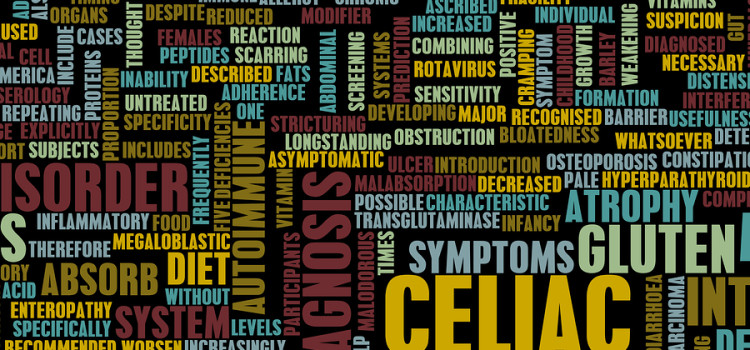If there’s one thing we can be sure of in today’s food trends, it’s that there is a market out there for gluten-free foods.
Where one once had to search through the city’s hidden health food stores, gluten-free products now line the shelves of standard grocery stores around the world.
Gluten-free aisles can be found in major chains, often branching out to include not only ready-made gluten-products but also the unique flours and grains necessary to bake your own gluten-free creations at home.

Why the sudden interest? Most significantly, we’ve seen a surge of interest in the gluten-free diet after it became a trend, with many sufferers of non-celiac gluten sensitivity (NCGS) claiming major relief after eliminating gluten from their diets. But as the diet takes on more and more popularity with those living with NCGS and those who just think it might be a good idea, it’s important to remember the cause of the original gluten-free diet: celiac disease.
Celiac disease is a digestive autoimmune disorder that affects 1 in 133 Americans. Also known as celiac sprue or gluten-sensitive enteropathy, celiac disease occurs as a negative reaction to gluten. Gluten, contrary to popular belief, does not just mean wheat. Gluten is a protein found in rye, barley, wheat, and hundreds of foods that are made with these grains. It’s often found in baked goods because its sticky consistency traps gases in dough as it rises.
When a person with celiac disease eats a food containing gluten, the body’s immune system reacts and causes damage to the lining of the small intestine. This damage makes it difficult for the body to absorb nutrients such as fat, iron, calcium, and folate.
What Health Problems Can Be Caused by Celiac Disease?
Celiac disease is accompanied in the short-term by severe gastrointestinal distress, and one might think that’s enough. Unfortunately, the nature of celiac disease is to damage the small intestine in a way that challenges the body’s ability to take in much-needed nutrition. That means that when left undiagnosed and untreated, celiac disease will slowly inhibit the body’s growth and stability as it fails to take in necessary nutrients form foods.
Over the long-term, any disorder caused by malnutrition can stem from the greater problem of celiac disease. Some health problems caused by celiac disease include:
- Miscarriage
- Infertility
- Osteoporosis, which can lead to fractures
- Cancer of the intestine
- Growth problems in children and teens
- Seizures
- Birth defects, such as neural tube defects
Those living with celiac disease (itself an autoimmune disease), may also suffer from other autoimmune diseases such as:
- Type 1 diabetes
- Lupus
- Thyroid disease (including Hashimoto’s)
- Rheumatoid arthritis
- Sjogren’s syndrome
Am I at Risk for Celiac Disease?
When faced with a long list of serious, long-term diseases and disorders like the one above, the natural question is, “How can I stop this from happening to me?”
While there are many disorders (such as type 2 diabetes) that can be prevented with proper lifestyle changes, unfortunately celiac disease is not one of them. Celiac disease is hereditary, and if you have a first-degree relative (parent, child, sibling) with the disease then you have a 1 in 10 risk of having it yourself.
That’s the bad news. The good news is that celiac disease does not have to be accompanied by that long list of autoimmune disorders and diseases caused by malnutrition. The only way to treat celiac disease is also the easiest and most important way: the gluten-free diet.
The immune system is meant to protect our bodies from invaders, such as foreign sickness or harmful germs. But when a person with celiac disease eats a food containing gluten, the immune system treats gluten as if it were one of those foreign invaders. Antibodies attack the gluten, which in turn attacks the lining of the intestines.
The intestines contain tiny structures called villi, which are designed to absorb nutrients from food. But when gluten attacks the intestinal lining, the intestines become inflamed. This causes short-term pain and discomfort, which is the least of our problems. It also damages the villi, so the body is unable to absorb nutrients from food. If left unchecked, a person with celiac disease eating gluten-containing products would ultimately suffer from malnutrition, now matter how nutritious the foods.
How Do I Know If I Have Celiac Disease?
You need to get tested in order to confirm celiac disease, but there’s generally no need to be tested if you don’t feel that you have a problem or could have a problem. While it’s true that most cases of celiac go undiagnosed, it’s also true that there are certain symptoms of celiac that tend to present themselves, and certain genetics that can predispose a person. If you don’t suffer from any of the symptoms, chances are you’re doing just fine with gluten in your diet. If you are genetically predisposed, you may wish to preemptively avoid gluten.
If you do are experiencing any of the common symptoms or have a family history of celiac disease, go get tested! You don’t have anything to lose, and early diagnosis or confirmation of susceptibility can be crucial to your long-term health. A 1999 study of patients with celiac disease found that the later the age of diagnosis, the greater the chance of developing an additional autoimmune disorder.
These are the symptoms to watch out for, particularly in infants and children:
- Constipation
- Irritability
- Pale or fatty stool (i.e., greasy-looking and/or floating rather than sinking)
- Delayed growth and puberty
- Short height
- Failure to thrive
- Loss of weight
- Exhaustion
- Attention deficit hyperactivity disorder (ADHD)
- Abdominal bloating and pain
- Diarrhea
- Vomiting
- Defects on the enamel of permanent teeth
While celiac disease is most noticeable in children when they suffer from digestive symptoms, adults are far less likely to exhibit such symptoms. Instead, adults suffering from celiac disease are likely to suffer from:
- Bone pain
- Osteoporosis
- Joint pain
- Iron-deficiency anemia
- Numbness in the hands and feet
- Seizures
- Migraines
- Fatigue
- Arthritis
- Missed menstrual periods
- Infertility
- Miscarriage
- Canker sores
- Depression
- Anxiety
- An itchy skin rash (dermatitis herpetiformis)
So I Have Celiac Disease. What Now?
A few things to know:
- There is currently no known cure.
- Sticking to a gluten-free diet can prevent all further damage.
Yes, it’s true that you aren’t going to find a pill that can convince your body to accept gluten forever. (At least, you aren’t going to find that yet.) And it’s true that the only way to move forward in a healthful way is to treat your celiac disease like a severe allergy. People with peanut allergies must avoid all contact with peanuts, and what you would need to do is similar.
That said, the helpful thing about the allergy comparison is that people who avoid the foods they’re allergic to are generally okay once they learn to do so. If your celiac disease was left untreated for long enough to cause significant damage (such as additional autoimmune disorders), then they’ll need to be treated by your doctor. But as for the source of the problem itself, celiac disease, the only thing you can do is to rethink your relationship to food. You love regular wheat-based muffins—and they’re destroying your intestines—what next?
For one thing, it can be a real challenge for those with celiac disease to get enough grains—at least when they’re still getting used to their new dietary restrictions. Grains are a great source of complex carbohydrates (including fiber), vitamins, and minerals. While you won’t be able to eat your grains mindlessly anymore, living with celiac disease may give you the chance to be more mindful about the grains you choose as your substitutes, which can be a major plus. Gluten-free whole grains, such as quinoa, flax, millet, sorghum, and teff, will prevent intestinal damage and provide more nutritional benefit than white flour ever did.
Here are some examples of healthy gluten-free products to get you started:
Breads
- Breads, muffins, and bagels made from potato, bean, soy, rice, corn sorghum, teff, or other flours
- Pancakes, waffles, and pizza crusts made from gluten-free flours
- Corn tortillas
- Homemade baked goods made from gluten-free flours
Cereals
- Puffed rice or quinoa
- Cornflakes, amaranth flakes, rice flakes
- Cooked cereal made from corn (grits, hominy), rice, amaranth, quinoa, or pure buckwheat
Snacks
- Popcorn
- Rice cakes
- Corn or potato crisps
Other
- Rice
- Kasha
- Pasta (made from quinoa, corn, rice, amaranth, pure buckwheat, or legumes)
- Flax
- Quinoa
- Corn
- Millet
As with any serious disorder, getting diagnosed with celiac disease can be nerve-wracking. All of a sudden, you have to keep to a diet—not a fad diet that you can break when you get invited to brunch, but a diet that will keep you alive.
But here’s another way to think about it: keeping to a gluten-free diet will first and foremost keep your body functioning. You’ll be able to absorb nutrients that you were previously unable to do, and you won’t suffer from malnutrition. Also, keeping to a gluten-free diet is an opportunity. This sudden need for planning and structure in your meals could be just what you need to motivate yourself to make good choices. Not only will be you able to absorb those nutrients, but little by little you’ll become more accustomed to new foods that are even more nutritious than the ones you previously ate.
5 Foods DESIGNED to make you gain weight!
Sources:
What Is Celiac Disease. In: Celiac Disease Foundation. Celiac.org. 2015 Jun 30. Retrieved 26 July 2015.
Celiac Disease. In: Celiac Disease Health Center. WebMD.com. Retrieved 26 July 2015.
National Foundation for Celiac Awareness. Fast Facts. In: Celiac Disease: Facts and Figures. Celiaccentral.org. 2015 July. Retrieved 26 July 2015.
Mayo Clinic Staff. Definition. In: Diseases and Conditions: Celiac Disease. Mayoclinic.org. 23 May 2013. Retrieved 26 July 2015.
NIH: National Institute of Diabetes and Digestive and Kidney Diseases. In: US National Library of Medicine: Medline Plus. 2015 July 13. Retrieved 26 July 2015.
Pomeroy, SR. Non-Celiac Gluten Sensitivity May Not Exist. In: Forbes.com 2015 May 2015. Retrieved 26 July 2015.
What Is Celiac Disease. In: Celiac Support Association. www.csaceliacs.org. 2015. Retrieved 26 July 2015.
Picco, MF. Expert Answers. In: Diseases and Conditions: Celiac Disease. Mayoclinic.org. 2012 Aug 9. Retrieved 26 July 2015.



